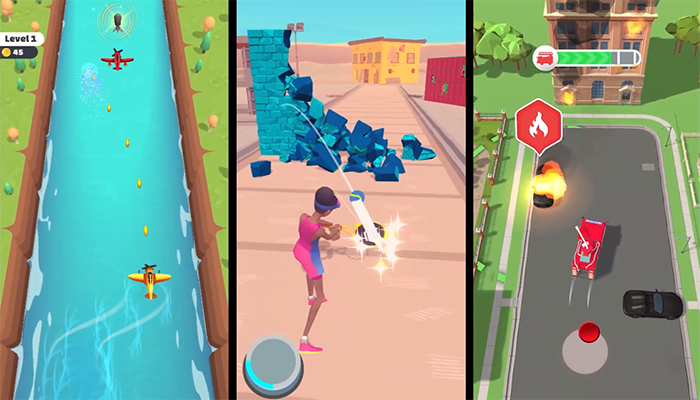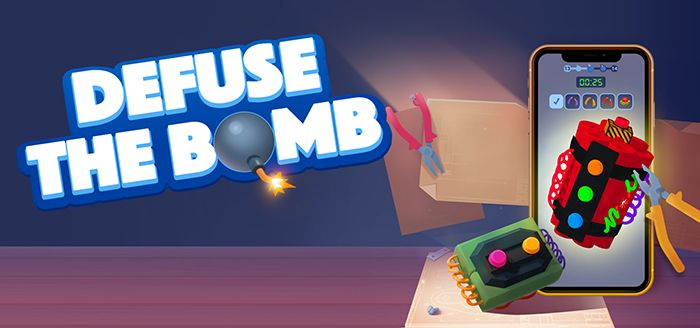
Now that you know us a little better, let's talk about this phenomenon called Hyper-Casual games.
It's hard to find someone who doesn't have at least one Hyper-Casual game on their phone. The phenomenon began in 2018, when this type of game began to appear on the top charts of mobile platforms.
We can summarize them as games that are very simple to understand and play. A Facebook campaign, with 4 seconds of gameplay video, is enough to convince a non-gamer to play on their cell phone for the first time. Yes, Hyper-Casual, with its very simple input (one finger), clear rules, and no punishment, was the first game for many new players. A phenomenon previously only seen in the Atari era, and more recently, with the launch of the Nintendo Wii. When people who didn't have the habit of having fun playing digital games decided to give this form of entertainment a chance.
According to a survey by Sensor Tower, in 2020, Hyper-Casuals were responsible for 31% of global downloads, representing more than 6.3 billion users.
What defines Hyper-Casual?
It is important to highlight that Hyper-Casual is not a genre, but rather a business model with well-defined premises. Any game that is simple and fun, and because of this, has an extremely broad audience, generating a low installation cost (CPI), will be considered a Hyper-Casual.
Another important characteristic of this category is the monetization model. 95% comes from Ads (in-game advertisements). Usually, using a very aggressive approach with many ads per game.
Even considering the characteristics above, it is very clear that the heart of a Hyper is its simple and fun mechanics. Yes, two words that do not naturally go together. It is not a simple task to build a fun and easy-to-understand game mechanic. Usually, this combination generates a game that is too simple. Sometimes, silly. The result of this is that 90% of Hyper-Casuals have extremely low retention (the time the player spends playing). In other words, players only have fun for a few days and then uninstall, or only change games when they are impacted by another more interesting campaign.
With this, we have a big question: How does such a short-lived product proposal generate such a promising business model?
The secret is that these few days of interaction, and using an aggressive Ads approach, the game is able to achieve a positive product ROI. After all, the formula follows the same: if the installation cost (CPI) is lower than the LTV (Life Time Value, value generated over the player's lifetime), we have a profit.
In short, we can understand the model by analyzing these 2 pillars: Marketing and Profit.
Marketing
Profit

Izyplay developed over 100 Hyper-Casuals in 2020.
IZYper-Casual
By understanding the rules described in the section above, we saw great potential to be explored. Our first prototypes were tested at the end of 2019. In March 2020, one of our ideas worked. A game that challenged the player to defuse a bomb, in the form of a 3D puzzle, following the instructions and within the stipulated time. Defuse the Bomb 3D reached 12 million downloads around the world, and taught us a lot about our development process, as well as a lesson in Game Design. How to entertain the player with something simple, but challenging at the same time? With lots of testing, with a focus on the user and rapid iterations.

Constant feedback from players, combined with the No Tutorials rule (there is no room for tutorials in Hyper Casual), ended up enabling our team to create self-explanatory mechanics, eliminating the need for screens or texts for instructions. Simplifying the input was a huge revolution for us. In the case of Defuse the Bomb, just one finger to rotate the bomb (Swipe), and Taps to interact with the various devices, covered the entire spectrum of player interaction. Over time, developing dozens of other prototypes, we naturally began to worry about making the game accessible to all types of players. And today this is in our DNA.
Another aspect that originated during our journey in Hyper-Casuals was data analysis. In this model, as already described in the previous section, testing and feedback begin very early. In the first week, we can already have data on how popular and interesting the idea is. In another week, we already have data on how players played the game, whether they had difficulty understanding the mechanics, or whether they were able to progress smoothly through the available levels. Thanks to this period in our trajectory, we now have a BI (Business Intelligence) team, responsible for evaluating market data - analyzing mechanics already tested by other studios - as well as measuring campaigns and playtests of our ideas. This work does not only occur at the beginning of development, but extends to the Live Ops stage.
Creating a Hyper-Casual is like creating a game “without some of our powers”. We cannot use overly elaborate graphics - since the player is not familiar with complex graphics and specific characters -, we have no room for narratives, or even soundtracks and sound effects. What we were left with was to invest all our effort in Game Design. This fact changed Izyplay completely.
Hyper-Casual, Hyper-Flood
The model described above ended up catching our attention and that of small studios, but also of Publishers around the world. The simple formula (CPI < LTV), which can be tested through a simple and fast-developing game (1 week on average), generated a flood of games and prototypes in 2020. The result of a competition in search of results generates many campaigns and a significant increase in the difficulty of achieving a low CPI. This, in turn, generated new methods, resulting in games 100% focused on appearing fun without having the ability to entertain for more than a few minutes. Momentary trends (such as the popular Netflix series, Squid Games), mechanics based on "pleasurable" actions (Popularized by the term ASMR), such as cutting a bar of soap, or even controversial situations involving diets, harassment and other questionable topics, took over the Charts.
In addition to this movement, the significant number of clones, or small variations of runner mechanics, made this niche quite uninteresting for some studios, such as us at Izyplay.
However, the model, which is entirely data-driven, focuses on rapid prototyping, creates a game that is 100% focused on its core mechanics, and, most importantly, is concerned with developing a game that is simple to play, easy to understand, and that reaches a large number of players and non-players. This was a complete disruption for us.
Given this situation, in 2021 we asked ourselves: Would it be possible to use this technique, this pipeline, to create more meaningful games? Would it be possible to use rapid prototyping techniques, a data-driven approach, and create games that would be played for weeks or months?
However, this topic is already the subject of the last publication in this series of articles, which aims to tell a little about our evolution within the gaming universe.

Article authored by Everton Vieira, CEO of Izyplay Game Studio.